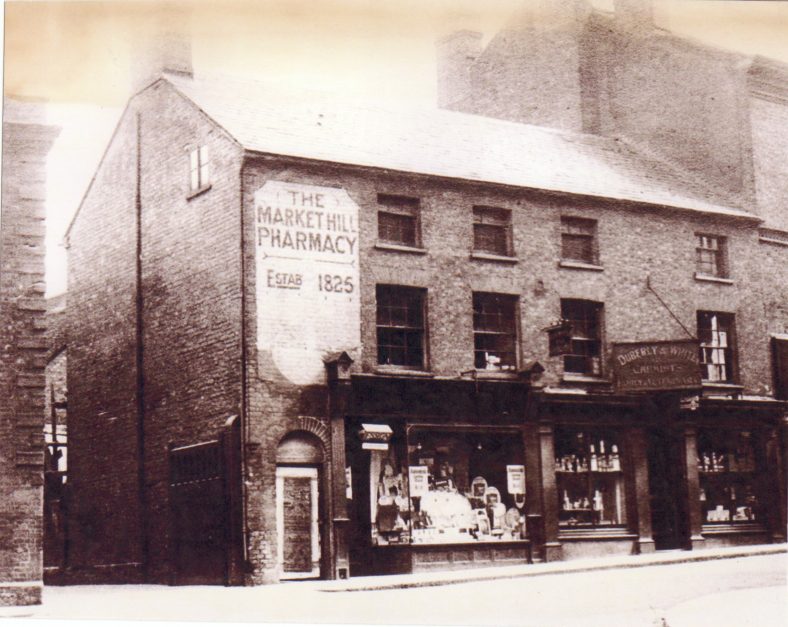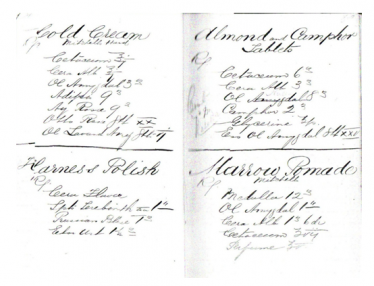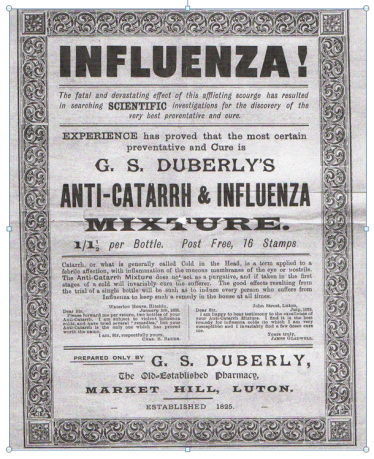During the 19th century, Luton’s population was about 4000. No less than four surgeons and four chemists and druggists were present in the town, prescribing not only medicines, but also selling a various range of products.

The Market Hill pharmacy in the early 20th century. The original shop was double fronted with the two windows under the sign the window to the left being a later addition.
Luton in the 19th century
At the beginning of Queen Victoria’s reign the population of Luton was about 4000. As recorded in Trade Directories for 1839 there were a surprising number of people engaged in trade or the professions. These included five hat manufacturers, twenty-four inns and public houses, four surgeons and four chemists and druggists; of the latter, it seems that only William Phillips had a shop, situated on Market Hill behind the Market Hall and next to the Crown Inn.
The Victorian pharmacies
Victorian pharmacies did far more than dispense prescribed medicines; in fact this was essential since it can be calculated that, at the Market Hill shop, only about two prescriptions were dispensed per week. The main source of income was from the manufacture and sale of a large variety of patent medicines, veterinary products and household items such as polish, ink, cosmetics and hair products including pomades;
The ingredients in medicines were derived mainly from plants with some minerals as they had been for centuries, a situation that continued well into the 20th century. Both prescribed medicines and patent medicines were made up by the chemist in his shop from these ingredients which were contained in glass bottles. Chemist’s shops were always recognizable by large glass vessels filled with coloured liquid which were prominently displayed.
The chemist shop
It is fortunate that a large quantity of material including prescription books and recipe books for the Market Hill pharmacy exists for almost the whole period of Victorian Luton. From these a picture can be built up of the medicines supplied and their costs together with the names of the more affluent Lutonians who could afford to see a doctor. The majority of the population had to rely on patent medicines. George Duberly, the proprietor in the last quarter of the 19th century, engaged in extensive, eye-catching advertising of his wares. The names in the prescription books are of many of the more affluent people in Luton in the Victorian period; these include R. Vyse, R. and T. Sworder, T. Waller, William Austin, Reverend Sikes and Henry Holyoak.
Of particular note are the owners of Luton Hoo and their staff, one of the first prescriptions is for the Marquis of Bute in 1841 for a digestion mixture. In one week of 1863 there was an outbreak of what appears to be gastro-enteritis at Luton Hoo affecting ten of the staff; despite having essentially the same symptoms the ingredients in the medicines prescribed by the same doctor are all different!
In conclusion, the Victorian chemist in Luton and similar small market towns could not rely for a living on the preparation of medicines prescribed by doctors. The great majority of his income came from the sale of patent medicines, veterinary products, and household products which he made up in his pharmacy.
1. David White, The First Pharmacy in Luton, Established in 1825. And the History of Duberly & White, 2011









No Comments
Add a comment about this page